In this article:
- Introduction
- Key Features and Benefits
- Application Scenarios
- Industry Perspectives
- Other Suitable Applications and Industries for the AAEON TGU8-EZBOX
- Suitable Sectors
- Key Features
- Block Diagram
- Technical Drawing
- Future Trends
- Conclusion
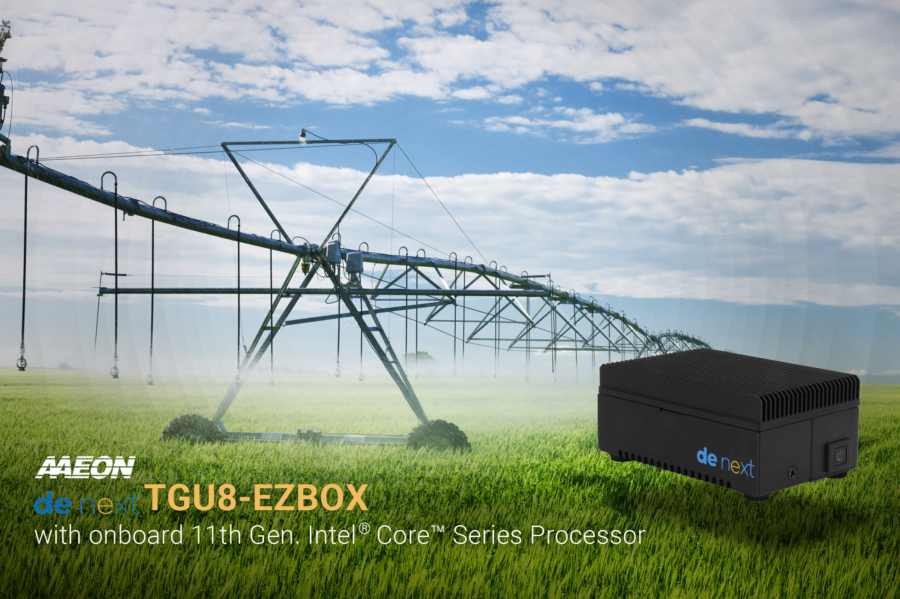
Introduction
Building on the success of the de next form factor, which featured the smallest single-board computers (SBCs) with Intel® Core™ and AMD Ryzen™ V2000 Series processors, AAEON has introduced the de next-TGU8-EZBOX.
As the first edge system in AAEON’s de next brand, the de next-TGU8-EZBOX stands out with its compact size and powerful capabilities, designed specifically for edge computing and IoT gateway solutions.
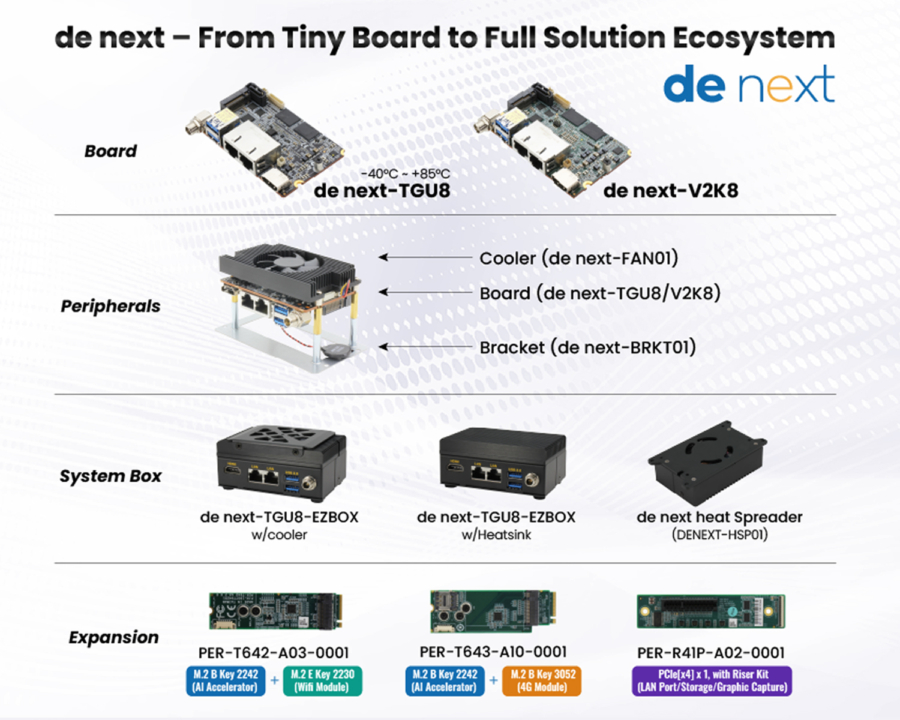
Key Features and Benefits
- Compact Size
The de next-TGU8-EZBOX is the world’s smallest edge computer with an embedded Intel® Core™ processor, measuring just 95.5mm x 69.5mm x 42.5mm with a heatsink and 95.5mm x 69.5mm x 45.4mm with an active cooler.
Benefit: This ultra-compact design makes the TGU8-EZBOX ideal for deployment in environments with limited space, such as industrial automation, smart retail, and smart cities. It can be easily integrated into existing systems without requiring significant space.
In industries where space is at a premium, such as manufacturing floors, retail environments, and urban infrastructure, the TGU8-EZBOX offers a solution that is both unobtrusive and powerful. Its small footprint ensures it can be placed in tight spots, mounted behind displays, or integrated into machinery without disrupting existing layouts.
- Fanless Heat Dissipation
The system offers fanless heat dissipation, ensuring low noise operation and protection against dust.
Benefit: These attributes are crucial for applications in digital signage and industrial markets where durability and reliability are paramount. The fanless design reduces maintenance needs and ensures a longer lifespan of the device.
Fanless systems are particularly beneficial in environments where dust and debris are common, such as factories and outdoor installations. The absence of moving parts not only enhances reliability but also makes the TGU8-EZBOX a silent operator, which is essential in noise-sensitive environments like offices, hospitals, and retail stores.
- High-Speed I/O Interfaces
The de next-TGU8-EZBOX retains many high-speed I/O features from its SBC counterparts, including two LAN ports (2.5GbE and GbE), two USB 3.2 Gen 2 ports, and one HDMI 1.4b port.
Benefit: These interfaces enable high-speed data transfer and versatile connectivity options, making the device suitable for complex industrial automation tasks, real-time data processing, and high-definition video applications.
High-speed LAN ports ensure fast and reliable network connections, which are essential for applications requiring real-time data transfer, such as surveillance systems, industrial automation, and remote monitoring. The USB 3.2 Gen 2 ports provide quick data transfer rates for peripherals, while the HDMI port supports high-definition video output, making the TGU8-EZBOX ideal for multimedia applications.
- Robust Memory and Storage Options
The system is equipped with 16GB of onboard LPDDR4x system memory and offers expansion through an M.2 2280 M-Key.
Benefit: High bandwidth and efficient data processing capabilities are essential for running intensive applications smoothly. The expandable storage meets diverse application requirements, from data logging in IoT gateways to running AI algorithms in edge computing.
Ample memory and storage are critical for edge devices that need to handle large datasets and perform complex computations locally. The 16GB of LPDDR4x memory ensures smooth multitasking and efficient processing, while the M.2 2280 slot allows for high-speed storage expansion, accommodating applications that require significant data storage and quick access times.
- Broad OS Compatibility
The de next-TGU8-EZBOX is compatible with multiple operating systems, including Windows 10 and Ubuntu 20.04.4 (Kernel 5.13).
Benefit: This broad compatibility facilitates easy integration into existing IT infrastructures and supports a wide range of development environments, ensuring flexibility for developers and system integrators.
Support for popular operating systems like Windows and Ubuntu ensures that the TGU8-EZBOX can be easily incorporated into various software ecosystems. This compatibility is crucial for businesses that rely on specific software applications and development tools, providing a seamless integration experience and reducing the learning curve for IT teams.
Expansion Module Ecosystem
While the TGU8-EZBOX’s compact size limits on-board expansion, it is part of a broader ecosystem that includes dedicated expansion modules like the PER-T642, PER-T643, and PER-R41P. These modules offer AI acceleration, Wi-Fi, 4G support, and PCIe expansion.
Benefit: These expansion options allow users to customise the TGU8-EZBOX for specific applications, such as AI processing, advanced connectivity, and enhanced industrial control. This modularity ensures the device can evolve with technological advancements and varying project requirements.
AI and Connectivity Expansion
For applications requiring advanced AI capabilities or enhanced connectivity, the PER-T642 and PER-T643 modules are invaluable. The PER-T642 supports AI acceleration or Wi-Fi modules, making it ideal for edge AI applications where local processing of AI tasks is crucial to reduce latency and bandwidth usage. The PER-T643, on the other hand, pairs AI acceleration with 4G support, providing robust connectivity options for remote and mobile applications.
Industrial Control Expansion
The PER-R41P module offers PCIe expansion along with a Riser Kit, enabling additional interfaces such as storage, graphic capture cards, and Ethernet. This flexibility is particularly beneficial for industrial control tasks where additional connectivity and processing power are required. By leveraging these expansion options, businesses can tailor the TGU8-EZBOX to meet specific operational needs, from advanced data analytics to enhanced machine control.
Application Scenarios
- Edge Computing
The de next-TGU8-EZBOX is perfect for edge computing tasks, providing the necessary processing power and connectivity to handle data locally, reducing latency and bandwidth usage.
Case Study: In a smart city scenario, the TGU8-EZBOX can be deployed at traffic intersections to process data from cameras and sensors locally. By analysing traffic patterns in real-time, the system can optimise signal timings, reduce congestion, and enhance traffic flow without the need for constant cloud communication.
- IoT Gateways
With its compact size and robust I/O options, the TGU8-EZBOX serves as an effective IoT gateway, managing and processing data from various IoT devices in real-time.
Case Study: In a smart agriculture setup, the TGU8-EZBOX can act as a gateway for soil moisture sensors, weather stations, and irrigation systems. By processing data locally and making real-time decisions, the system can optimise water usage, improve crop yields, and reduce resource wastage.
- Industrial Automation
The device’s high-speed interfaces and reliable design make it suitable for industrial automation, where it can control machinery, collect data from sensors, and interface with other industrial systems.
Case Study: In a manufacturing plant, the TGU8-EZBOX can be used to monitor and control production lines. By integrating with various sensors and actuators, the system can ensure efficient operations, detect anomalies, and trigger maintenance alerts to prevent downtime.
- Digital Signage
The fanless design and high-resolution HDMI output make the TGU8-EZBOX an excellent choice for digital signage, ensuring silent operation and vivid displays in public spaces.
Case Study: In retail environments, the TGU8-EZBOX can power interactive digital signage that engages customers with dynamic content. By integrating with sensors and cameras, the system can deliver personalised advertisements and gather data on customer interactions.
- Smart Retail
In smart retail environments, the TGU8-EZBOX can power interactive kiosks, manage inventory systems, and provide real-time data analytics, enhancing the overall customer experience.
Case Study: In a smart store, the TGU8-EZBOX can be used to run self-service kiosks, manage inventory in real-time, and analyse customer behavior. By providing actionable insights, the system can help retailers optimise product placement, manage stock levels, and improve customer satisfaction.
Industry Perspectives
Digital Transformation
The TGU8-EZBOX plays a crucial role in the ongoing digital transformation across various industries. As businesses adopt more IoT devices and edge computing solutions, the demand for compact, powerful, and versatile edge systems like the TGU8-EZBOX will continue to grow. Its ability to process data locally, connect with numerous devices, and operate reliably in harsh environments makes it an indispensable tool for modern enterprises.
Sustainability
In addition to its technical capabilities, the TGU8-EZBOX contributes to sustainability efforts by reducing the need for extensive cloud computing resources. By handling data processing at the edge, it minimises data transfer to centralised data centers, thereby lowering energy consumption and reducing the overall carbon footprint. This is particularly important for businesses looking to meet sustainability goals and reduce operational costs.
Security
Edge computing solutions like the TGU8-EZBOX enhance data security by keeping sensitive data local. This reduces the risk of data breaches during transmission and ensures that critical information is processed and stored securely. For industries dealing with confidential data, such as healthcare, finance, and government, this added layer of security is invaluable.
Other Suitable Applications and Industries for the AAEON TGU8-EZBOX
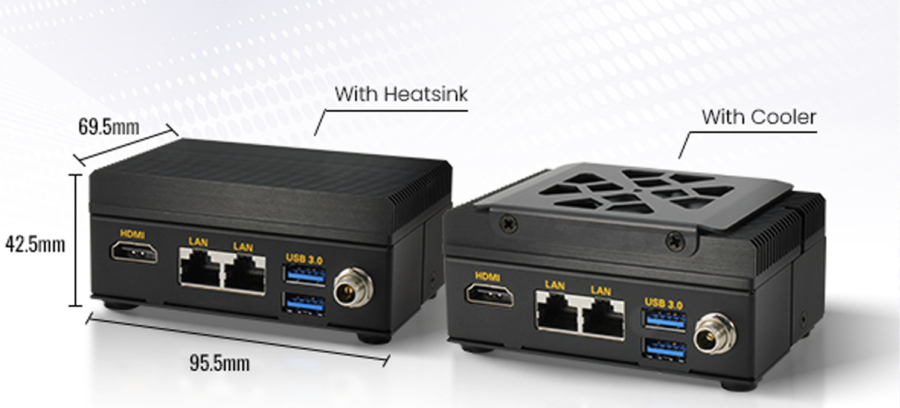
The AAEON TGU8-EZBOX, with its compact size, powerful processing capabilities, and versatile connectivity options, is well-suited for a variety of applications across multiple industries. Here are some detailed applications and the corresponding industries where the TGU8-EZBOX can be effectively utilised:
Applications
- Edge Computing
- Function: Local data processing and decision-making.
- Benefit: Reduces latency, minimises bandwidth usage, and enhances real-time responsiveness.
- Example: Traffic management systems in smart cities.
- IoT Gateways
- Function: Aggregating and processing data from various IoT devices.
- Benefit: Provides real-time data analytics and control, facilitating efficient IoT device management.
- Example: Smart agriculture monitoring systems.
- Industrial Automation
- Function: Control and monitoring of industrial machinery and processes.
- Benefit: Ensures efficient operations, real-time monitoring, and predictive maintenance.
- Example: Automated manufacturing lines and robotic control systems.
- Digital Signage
- Function: Powering interactive displays and advertising boards.
- Benefit: Delivers dynamic and high-definition content with silent operation.
- Example: Retail store interactive kiosks and airport information displays.
- Smart Retail
- Function: Managing inventory, customer interactions, and point-of-sale systems.
- Benefit: Enhances customer experience and operational efficiency.
- Example: Self-service checkouts and real-time inventory tracking systems.
- Surveillance and Security
- Function: Real-time video processing and analytics for security purposes.
- Benefit: Enhances security measures with local data processing, reducing dependency on cloud resources.
- Example: Intelligent surveillance systems in public areas and buildings.
- Healthcare
- Function: Monitoring and managing medical devices and patient data.
- Benefit: Provides real-time data processing for critical healthcare applications.
- Example: Remote patient monitoring and telemedicine systems.
- Environmental Monitoring
- Function: Collecting and analysing data from environmental sensors.
- Benefit: Enables real-time monitoring of environmental conditions, supporting sustainability efforts.
- Example: Air quality monitoring systems in urban areas.
- Energy Management
- Function: Managing and optimising energy consumption and production.
- Benefit: Enhances energy efficiency and reduces operational costs.
- Example: Smart grid management and renewable energy monitoring systems.
- Transportation and Logistics
- Function: Managing fleet operations and logistics data.
- Benefit: Improves operational efficiency and real-time tracking of assets.
- Example: Fleet management systems and real-time tracking of shipments.
Suitable Sectors
- Manufacturing
- Applications: Industrial automation, predictive maintenance, quality control.
- Benefit: Enhances production efficiency, reduces downtime, and improves product quality.
- Retail
- Applications: Smart retail, digital signage, inventory management.
- Benefit: Improves customer experience, optimises inventory levels, and increases sales.
- Smart Cities
- Applications: Edge computing, environmental monitoring, traffic management.
- Benefit: Enhances urban infrastructure, improves public services, and supports sustainability.
- Healthcare
- Applications: Remote patient monitoring, medical device management, telemedicine.
- Benefit: Improves patient care, enhances operational efficiency, and supports remote healthcare services.
- Transportation
- Applications: Fleet management, real-time tracking, smart transportation systems.
- Benefit: Increases operational efficiency, reduces costs, and enhances safety.
- Agriculture
- Applications: IoT gateways, environmental monitoring, smart irrigation.
- Benefit: Optimises resource usage, improves crop yields, and supports sustainable farming practices.
- Energy
- Applications: Energy management, smart grids, renewable energy monitoring.
- Benefit: Enhances energy efficiency, reduces costs, and supports the integration of renewable energy sources.
- Public Safety and Security
- Applications: Surveillance systems, emergency response, intelligent security.
- Benefit: Enhances public safety, improves response times, and supports real-time threat detection.
- Environmental Science
- Applications: Environmental monitoring, data analytics, sustainability initiatives.
- Benefit: Supports environmental protection, enhances data-driven decision-making, and promotes sustainability.
- Logistics
- Applications: Real-time tracking, warehouse management, supply chain optimisation.
- Benefit: Increases efficiency, reduces costs, and improves supply chain visibility.
The AAEON TGU8-EZBOX is a versatile and powerful edge computing solution that can be tailored to meet the needs of a wide range of applications across diverse industries. Its compact design, robust performance, and flexible expansion options make it an ideal choice for businesses looking to enhance their operations, improve efficiency, and embrace digital transformation.
Key Features
Onboard 11th Gen. Intel® Core™ Series Processor, TDP 15W
■ Onboard LPDDR4x 3733 up to 16GB
■ HDMI 1.4b x 1
■ 2.5GbE RJ45 x 1, GbE RJ45 x 1
■ USB 3.2 Gen 2 x 2
■ M.2 2280 M-Key x 1 (PCIe [x2] x 1)
■ DC 12V in
■ Multiple Dissipation Solutions: with CPU Cooler/Heatsink
Block Diagram
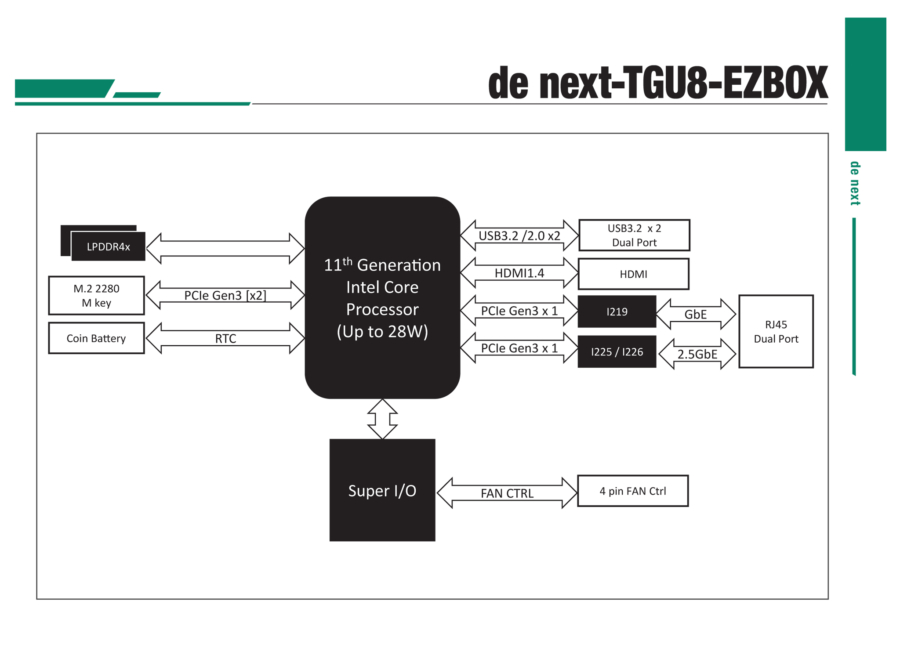
Technical Drawing
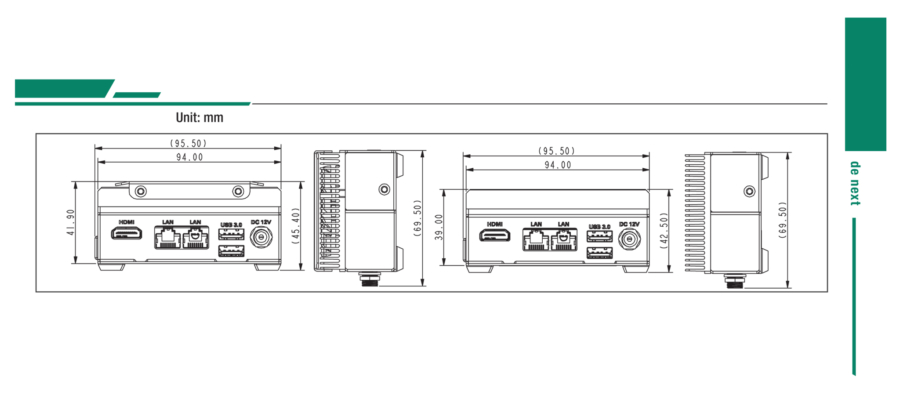
Future Trends
Integration with AI and Machine Learning
As AI and machine learning continue to evolve, the TGU8-EZBOX is well-positioned to take advantage of these advancements. By integrating AI acceleration modules, the system can perform complex computations and data analysis at the edge, enabling real-time decision-making and enhancing operational efficiency.
5G Connectivity
The advent of 5G technology will further enhance the capabilities of the TGU8-EZBOX. With faster and more reliable connectivity, the system can support more IoT devices, handle larger data volumes, and provide quicker response times. This will open up new possibilities for applications in autonomous vehicles, remote healthcare, and smart infrastructure.
Edge-to-Cloud Collaboration
While edge computing reduces the reliance on cloud resources, the future will see more collaboration between edge and cloud systems. The TGU8-EZBOX can serve as a bridge, processing data locally and then transmitting relevant information to the cloud for long-term storage and comprehensive analysis. This hybrid approach combines the best of both worlds, ensuring efficient data processing and robust data management.
Conclusion
The AAEON de next-TGU8-EZBOX sets a new benchmark for edge computers with its compact size, robust performance, and versatile connectivity. Its compatibility with a wide range of expansion modules and operating systems makes it an adaptable solution for various industrial and IoT applications. As part of the expanding de next ecosystem, the TGU8-EZBOX demonstrates AAEON’s commitment to innovation and practical solutions in the edge computing landscape.
By addressing the specific needs of edge computing, IoT gateways, industrial automation, digital signage, and smart retail, the TGU8-EZBOX emerges as a powerful and versatile tool for modern enterprises. Its compact design, fanless operation, high-speed interfaces, robust memory, and broad OS compatibility ensure that it can meet the diverse demands of various industries. As businesses continue to embrace digital transformation, the TGU8-EZBOX will play a critical role in shaping the future of edge computing and IoT solutions.










